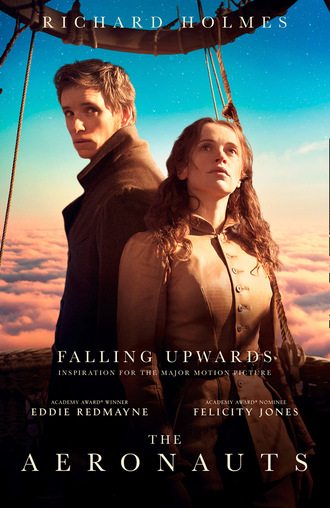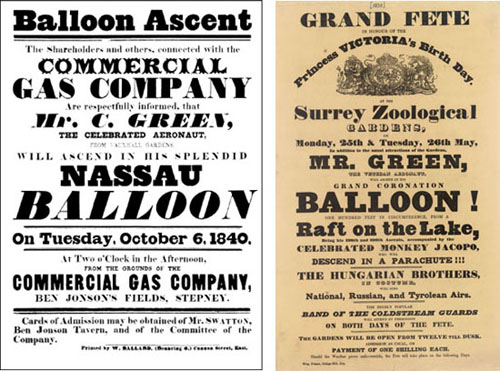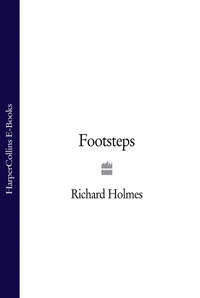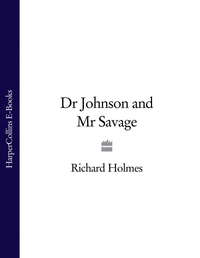
Полная версия
Falling Upwards
They were recreational balloons in several senses, constructed and flown by a new breed of balloon businessmen and entertainers, aerial entrepreneurs who regarded themselves as skilled professionals as well as artists of the air. Crucial to their commercial success was the discovery that coal gas, cheap and reliable and easily available from the urban ‘mains’, could be substituted for expensive and unstable hydrogen. Their most memorable flights would also be over urban landscapes.
Drifting silently above London or Paris, or any of the industrialised centres of northern Europe, they granted their passengers a new and instructive kind of panorama. They revealed the extraordinary and largely unsuspected metamorphosis of these cities, with their new industries and their hugely increased populations. What they found spread out below them had never been seen before in history. It was both magnificent and monstrous: an endless panorama of factories, slums, churches, railway lines, smoke, smog, gas lighting, boulevards, parks, wharfs, and the continuous amazing exhalation of city sounds and smells. Above all, what they saw from ‘the angel’s perspective’ was the evident and growing divisions between wealth and poverty, between West End and East End, between blaze and glimmer.
2
The most celebrated British balloonist of this second generation was Charles Green (1785–1870). He was famed for his 526 successful ascents, and his absolute sang-froid in emergency. An annual Charles Green Silver Salver is awarded to this day by the British Balloon and Airship Club for the most impressive technical flight of the year. Green’s portrait in the National Portrait Gallery presents him like a plain, good natured farmer. He sits stiffly at a window, with his famous striped Royal Nassau balloon hanging in the sky above his right shoulder. His image is rendered with the solidity and simplicity of an English pub sign. Yet his character was far from straightforward: a curious mixture of earth and air, of ballast and inflammable gas, of the worldly and the visionary.

Everyone agreed that the stocky and rubicund Green was jovial and easy-going on the ground. Yet he became strangely fierce and commanding in the air, a veritable martinet. This kind of Janus-like character can sometimes be found among amateur yachtsmen – twinkling and expansive in the club bar, but fiery authoritarians at the helm. It has perhaps something to do with the loneliness and stress of command. In ordinary company, a contemporary journalist found Green ‘garrulous, and delighting all with his intelligence, his enterprise, his enthusiasm and his courtesy’. But once installed in the aerial kingdom of his balloon basket, he became ‘taciturn, and almost irritable’, rarely speaking, but always ready to ‘roar out’ commands at crucial moments of manoeuvring or landing. Apart from his balloon logbooks, he left few, if any, written accounts of his own flights. Yet he inspired others to do so, and many of the classic descriptions of Victorian ballooning, especially over London, by John Poole (1838), Albert Smith (1847) and Henry Mayhew (1852), were written after memorable voyages with Charles Green.4
Green came from a family of fruit merchants, based in Goswell Street on the edge of the City of London. This was, and still is, a bustling district of small businesses and shops, modest houses and working cafés. It is where Dickens’s Pickwick Papers begins, with Mr Pickwick leaning out of his lodging windows onto Goswell Street and greeting ‘that punctual servant of all work, the sun’ on a cheerful morning in 1827. How or when Green became fascinated by ballooning remains a mystery. Fruit and veg do not seem an obvious source of aerial longings. He would only say that ballooning started as a hobby, after he had been trying to improve the gas lighting in the family shop. Possibly the idea for using mains coal gas to inflate a balloon came to him during these experiments.5
Born in 1785, Green was working full-time in his father’s shop from the age of fifteen, and little is known about his earliest flights until 1821, when he was approaching forty. It would seem that he began ballooning when he was already a successful businessman, perhaps as a kind of sport, and was determined to find a way around the huge expense of hydrogen. He made his first ascent using coal gas, from the newly installed Piccadilly mains, launching from Green Park in London on 19 July 1821. But Green must already have had some reputation as a balloonist, for the launch was part of the public celebrations for the coronation of George IV, the balloon was decorated with the royal arms, and the site at Green Park was close to St James’s Palace. This was not usually a place of popular entertainment, and the ascent must have been officially sanctioned and even subsidised.
Green gradually established himself as part of a new generation of professional balloonists. They could hire out their services, and their balloons, to any employer or institution who wanted to celebrate a special occasion or mark a notable event. But initially Green still had to put on novelty shows like Garnerin, and he is recorded as ascending on the back of a horse harnessed to his balloon hoop from the Eagle Tavern, City Road, in August 1828. This was the same tavern from which Lieutenant Harris and Miss Stocks had launched their fatal flight four years previously.
A friend gave a whimsical description of Green in these early fairground days, going aloft on the back of a pony, while feeding him by hand with beans. He added a brief biography of the pony’s career with Green: ‘Finally having experienced more ups and downs than any horse, perhaps, that ever existed, he quitted a life of public service, and was buried in the garden of his master at Highgate where he now reposes.’6

What made Green exceptional, quite apart from his flying skills, was his ability as a businessman. He drastically reduced the cost of commercial ballooning by negotiating an agreement with the London Gas Light and Coke Company to purchase coal gas to power his balloons. The concept of using ‘pit-coal’ gas for ballooning was not new, and had been recommended by Tiberius Cavallo in his Aerostation study as long ago as 1785. But it took Victorian technology and enterprise to apply it. The London Gas Company had itself only been founded in 1812, but within five years it had laid nearly thirty miles of gas mains, and a decade later had more than enough capacity to inflate Green’s balloons.
Green had calculated, using experiments with small models, that household coal gas was about half as effective as hydrogen, but less than a third of the cost. A seventy-thousand-cubic-foot balloon would cost £250 to inflate with hydrogen, but only about £80 with coal gas. It was also much quicker and safer to use, as it was delivered under pressure by the urban gas mains, which also supplied street lamps and public buildings.7
By 1835 Green had made over two hundred ascents, and established himself as the leading professional balloonist in Britain. He had also invented a new piece of balloon technology: the trail rope. This was a simple, self-regulating ballast device, which allowed a gas balloon to adjust its own height when flying at altitudes below five hundred feet. Made of heavy manila cordage, the trail rope was winched out of the basket and simply left to drag along the ground several hundred feet below. Whenever the balloon dropped closer to the ground, more trail rope – and hence more ballast weight – was transferred from the balloon basket to the earth. Thus lightened, the balloon would rise again to a new point of balance. It was a very neat form of homeostatic device, typical of Green’s supremely practical turn of mind. He never attempted to patent it, and it was soon employed by aeronauts across Europe.
Of course the trail rope could not be used over cities, or any kind of built-up or industrialised area. But apart from London and the sea ports, the cathedral cities of the shires and the manufacturing towns of the Midlands, England was still very largely a rural landscape. So Green employed his trail rope with what now seems amazing insouciance across the whole countryside: dragging it crashing through lines of trees and hedgerows, hissing across fields of crops or cattle, and not infrequently lifting the odd tile or slab of stonework from church roofs or isolated barns. This was a land still without barbed wire, let alone telegraph lines or electrical pylons, and the trail rope suggests a lost age of open parklands, isolated villages and largely unpopulated countryside.fn12 If he descended on a gentleman’s estate, Green could expect immediate help from the estate labourers, and usually a warm welcome and much hospitality from the squire at the great house. The balloon was in its own way an old-fashioned expression of pastoral values and pleasures.
But it was also a commercial proposition. In 1836 Green negotiated an agreement with Frederick Gye and Richard Hughes, proprietors of the immensely popular Vauxhall Pleasure Gardens, on the banks of the Thames, to supply balloon events as part of the garden’s attractions to Londoners, alongside brass bands, food stalls and horse-riding. Balloons were also a superb new means of publicity. For the next twenty years Vauxhall became associated with spectacular balloon launches, and various balloon dramas, until it was finally closed in 1859.
Part of Green’s contract provided him with the finances to construct to his own specification a huge eighty-foot-high coal-gas balloon with a seventy-thousand-cubic-foot capacity. It cost £2,000, an unheard-of sum, and was known initially as the Royal Vauxhall. Its livery was a red-and-white vertical candy stripe, with a Latin inscription from Ovid’s Metamorphoses emblazoned grandly round the circumference: ‘Caelum certe patet, ibimus illi’ – ‘Surely the sky lies open, let us go that way!’fn13 This was taken as signifying an appropriate pedagogical gesture on the part of Green or the Vauxhall proprietors: balloon travel was not mere entertainment, it would open the mind as well as the skies.

The Royal Vauxhall was capacious, with a nine-foot oval wickerwork basket, capable of carrying at least nine passengers, as well as a massive grappling iron and a huge hand-cranked winch to raise and lower the famous manila trail rope. To begin with it supplied paying passengers with short, tethered ascents to a hundred feet, so they could admire a view that stretched right up the Thames to the Houses of Parliament and St Paul’s. Equally, of course, the balloon could itself be seen for miles around London, a hugely effective piece of advertising.
After various preliminary trials, Green pulled off the most spectacular advertising coup for the Gardens in November 1836, when he set out on a legendary overnight flight from London to the Continent. The balloon team consisted of Green himself, Robert Hollond, a wealthy MP who partly financed the flight, and Monck Mason, an Irish musician and balloon enthusiast (suitably, he played the flute) who talked and wrote with great fluency, and undertook to record the whole event.
The departure was well publicised, especially the spectacular list of supplies that were intended to victual the three-man crew for up to three weeks. These included forty pounds of ham, beef and tongue; forty-five pounds of cooked game and preserves; forty pounds of bread, sugar and biscuits; and not least sixteen pints each of sherry, port and brandy, together with several dozen bottles of champagne. By dividing these figures by sixty, it is possible to estimate the minimum that each of these three Victorian gentleman was expected to consume per diem. For example: one and a half pounds of meat, half a pound of biscuits, a pint of fortified wines, and several glasses of champagne. Indeed, Mason made many jokes about the ‘high flavour and exalted merits’ of their supplies.
Much of the weight of these provisions (two hundred pounds) would eventually of course become expendable organic ballast, although the exact arrangements for disposing of this were not advertised. To this was added four hundredweight of the actual sand ballast, hung in sacks round the outer edge of the basket.9 Overall, the weight and worldly solidity of the crew’s creature comforts were seen not as luxuries, but as a guarantee of good preparation and serious intent. In a gas balloon the amount of ballast defined the potential for remaining airborne.
Of course, food supplies were not their only baggage. There was heavy clothing including cloaks and fur hats; carpet bags for personal items; repair equipment and maps; ‘speaking trumpets, barometers, telescopes, lamps, wine jars and spirit flasks’; the mighty trail rope; hundreds of extra yards of rope and cordage; Bengal flares; and a patent safety lamp, designed on the principle of the Davy miner’s lamp. Finally there was Green’s particular delight, a patent portable coffee-brewer. Ingeniously, it worked by ‘slaking’ a supply of quick lime with water in a metal canister, thereby producing ‘chemical heat’ (calcium hydroxide) without any open flame. Moreover, it could be emptied and replenished as required.10
Most of these articles were suspended above the crew’s heads, around the wooden hoop of the balloon, in a carousel of swinging sacks and nets and bags, producing the effect of some fabulous airborne hardware store. The total payload or lifting capacity of the eighty-foot Vauxhall – including the men, the equipment, the supplies and the sand ballast – was just under three thousand pounds, the equivalent of about fifteen robust men (or a modern rugby team with their boots on).
3
Watched by an enormous crowd, they launched from the Cremorne section of the Vauxhall Gardens at 1.30 p.m. on 1 November 1836, with approximately three hours of daylight in hand. They sailed rapidly eastwards across London, down the Thames, over Rochester, diagonally across north Kent towards Canterbury and the North Foreland. This line of flight would take them over the Goodwin Sands, out across the North Sea towards the Baltic, and possibly even Scandinavia. It was much too far north for Green’s liking.
Green immediately impressed his crew with a quietly confident demonstration of balloon navigation. If they gained height, he announced, they would turn south. He briskly ordered Mason to release half a sack of ballast, and they watched silently as the whole horizon appeared to revolve beneath them, turning slowly and ‘majestically’ northwards at Green’s command. At first confused, Mason gradually realised that the Vauxhall had entered an upper airstream and was flying due south towards Dover. ‘Nothing could exceed the beauty of this manoeuvre,’ he thought.11
They sailed over the first twinkling lights of Dover port at exactly 4.48 p.m., ‘almost vertically over the Castle’.12 It was precisely the point from which Blanchard and Jeffries had begun their historic flight almost fifty-one years before. They crossed the Channel just before dusk, overflying Calais at three thousand feet, and then dropping to recover the easterly airstream. As the last light failed, Green calculated their average land speed so far at twenty-five miles per hour, with the probability that it would increase over the flat expanses of Flanders and Belgium. They were now on a compass course of approximately 100 degrees, a fraction south of due east, headed in the general direction of Brussels, Liège, Cologne, Frankfurt, Prague, Moscow … So the balloon disappeared into the gathering penumbra of Continental Europe.
Their next act was to sit down to a huge meal of cold meats and wine, spread on the central work bench of their basket, and accompanied with ‘other liquors’. Mason noted that the champagne was unmanageable at any altitude, as due to the lower pressure it simply shot frothing out of the bottle, revealing what he called its ‘natural tendency to flying’.13 Perhaps under the influence of these refreshments, the landscapes of northern France seen after dusk, with isolated points of candlelight ‘burning late’ in the villages below, seemed infinitely romantic and mysterious. Equally, the bigger towns, now lit by gaslight, glowed on the horizon like unearthly sources of energy and activity. Their reflected radiance bloomed yellow and purple in the thickened atmosphere above the balloon: a first indication of urban pollution.
By midnight they had been airborne for nearly twelve hours, already something of a record. They were now flying towards the flaring lights of some huge industrial complex, distinctly set on the banks of a large river running north and south. They identified this as the river Meuse, and realised that they must have long since passed south of Brussels. The town was too big to be either Charleroi or Maastricht, and the only possibility remained Liège. They were astonished that such an ancient city should be surrounded by so much modern industry. Approached by air, and at night, this became dramatically evident.
Nestling in the valley of the river Meuse, with its historic churches and ancient markets, Liège was once the tranquil centre of the traditional textile trade of northern France. But as part of the newly independent Belgium it been transformed into one of the largest centres of heavy industry in the coalmining belt of northern Europe. With a population of nearly a hundred thousand labourers, it supported a growing number of huge ironworks and foundries, which were worked in shifts without ceasing twenty-four hours a day. Its commercial port was the third largest river port in Europe, with direct river and canal connections to Antwerp, Rotterdam and Aachen. Massive supplies of coal, iron ore and other raw materials were constantly shipped in by barge, while a steady stream of metal goods, guns and engineering parts were hurried away south-eastwards into France and south-westwards into Germany.
The balloonists, silently approaching through the night and flying very low, were transfixed by the unearthly glare of the fiery foundries moving swiftly towards them out of the darkness. The ancient centre of the city itself, set peacefully round the great oxbow curve of the Meuse, ‘the theatres and squares, the markets and public buildings’, slid quietly beneath them. But the surrounding districts ‘appeared to blaze with innumerable fires … to the full extent of all our visible horizon’.14
As they floated over this industrial inferno, they were gradually overwhelmed by the thunderous machine noise, the choking industrial smells, and the haunting sound of men below still working on the night shifts. There was disembodied shouting, coughing, swearing, metallic banging and sometimes, weirdly, sharp echoing bursts of laughter. They were being granted a unique, nightmare vision of the new industrial future, a world of ever-extending ironworks where every street was ‘marked out by its particular line of fires’. It was what Mason called the strangest glimpse of a ‘Cyclopean region’.
Mason’s disturbing account of passing over Liège later became famous in aeronautical circles. The French aeronaut Camille Flammarion recalled it as he made the same night flight over the symbolic city thirty years later. But for Flammarion, the experience was subtly different. He pointed enthusiastically to the industrial lights as they approached: ‘See, mon ami! See how beautiful this is! Do not dream of days gone by …’ The vision of manmade power and productivity deeply impressed him: ‘The Belgian towns, lit up by gaslight and the flames issuing from the smoky summits of the blast furnaces seemed to us silent aerial navigators the most dazzling spectacle. The deep sound of the Meuse, as it flowed along its course, was orchestrated by the sharper noises from the workshops, whose mysterious flames and dark smoke rose in the distance all around us.’15
But the English balloonists were shaken. Uncharacteristically distracted, Green mistakenly let their expensive coffee-brewing device fall overboard. Mason recorded this unusual error dispassionately. Having opened it over the side of the basket to shake out the expended materials, ‘Mr Green unfortunately let it slip from his hand’.16 Even less in character, Green then started to play a curious trick on the unsuspecting foundry workers below.
He lit a blazing white Bengal light, and lowered it on a rope until it was skimming ‘nearly over their heads’. He then urged Mason to shout down through the speaking trumpet ‘alternately in French and German’, as if some supernatural power was visiting them from on high. The ironworkers were being visited by the gods of the air.
Mason complacently imagined how this aeronautical trick must have ‘struck terror’ into even the boldest hearts and wisest heads of the ‘honest artizans’ beneath: ‘Catching alone the rays of the light that preceded from the artificial fire-work that was suspended close beneath us, the balloon, the only part of the machine visible to them, presented the aspect of a huge ball of fire, slowly and steadily traversing the sky, at such a distance as to preclude the possibility of it being mistaken for any of the ordinary productions of Nature …’17
As the Bengal light went out, they completed this supernatural effect by emptying half a bag of ballast sand directly onto the upturned faces a hundred feet below. Then the balloon sailed silently and invisibly away, leaving behind the puzzled tribe of Belgian foundry workers staring uncomprehendingly upwards, as these mysterious superior intelligences disappeared. ‘Lost in astonishment, and drawn together by their mutual fears,’ Mason concluded, ‘they stood no doubt looking up at the object of their terrors.’18 So the gods were also treating the ironworkers as if they were some primitive tribe.

Mason’s account of the voyage, Aeronautica, has several illustrations, views and cloudscapes, among them a very strange, dramatic one entitled ‘Balloon over Liège at Night’, taken from an imaginary point outside the basket looking across at the crew. Their faces are weirdly illuminated by the Davy lamp hung from the balloon hoop. The curving river Meuse, and the blazing foundries, are visible in the darkness below.
After midnight it was the crew’s own turn to be alarmed. Gradually all human lights on the ground disappeared. The moonless night seemed to close in around them, encircling them completely, even from below. It was an increasingly disturbing sensation. ‘The sky seemed almost black with the intensity of night … the stars shone like sparks of the whitest silver scattered upon the jetty dome around us. Occasionally faint flashes of lightning would for an instant illuminate the horizon … Not a single object of terrestrial nature could anywhere be distinguished; an unfathomable abyss of “darkness visible” seemed to encompass us on every side.’19
What was so frightening and disorientating was that the darkness seemed increasingly solid. Gone was the classic balloon feel of airy vistas, glowing luminosity and huge benign openness. The night was thickening into an alien substance. It was menacing and claustrophobic, entrapping and imprisoning them. Mason records no conversation with Green or Hollond at this time, but afterwards tried to describe what were clearly shared sensations: ‘A black, plunging chasm was around us on all sides, and as we tried to penetrate this mysterious gulf, we could not prevent the idea coming into our heads that we were cutting a path through an immense block of black marble by which we were enveloped, and which, a solid mass a few inches away from us seemed to melt as we drew near, so that it might allow us to penetrate even further into its cold and dark embrace.’20









